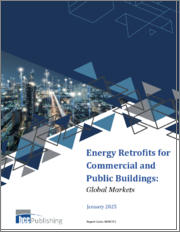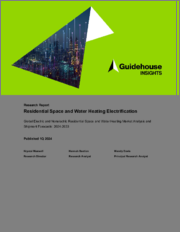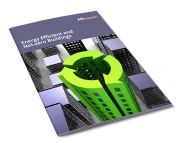
|
시장보고서
상품코드
1379544
에너지 효율적 건물 시장 - 세계 산업 규모, 점유율, 동향, 기회, 예측 : 건물 유형별, 구성요소 유형별(환기 시스템, 조명 기술, 에너지 관리 시스템, 제어), 지역별, 경쟁(2018-2028년)Energy-Efficient Building Market-Global Industry Size, Share, Trends, Opportunity, & Forecast Segmented by Building Type, Component Type (Ventilation Systems, Lighting Technologies, Energy Management Systems, & Controls), Region, Competition 2018-2028 |
||||||
세계 에너지 효율적 건물 시장 규모는 2022년 1,227억 달러에 달하고, 2028년까지 6.98%의 CAGR로 예측 기간 동안 강력한 성장세를 보일 것으로 예상됩니다.
에너지 효율적 건물은 기존 건물에 비해 난방, 냉방, 조명 및 기타 운영에 필요한 에너지 사용량을 크게 줄일 수 있습니다. 이러한 감소는 설계 전략, 첨단 재료 및 에너지 효율이 높은 기술의 조합을 통해 이루어집니다. 이 건물들은 효과적인 환기 시스템, 저배출 물질 및 공기 여과 기술을 도입하여 실내 공기질을 우선시합니다. 공기질 개선은 거주자의 건강과 편안함에 기여합니다. 벽, 창문, 지붕, 단열재를 포함한 건물 외벽은 열전도를 최소화하고 공기 누출을 방지하여 실내 온도를 안정적으로 유지하도록 설계되었으며, LED(발광 다이오드) 조명기구와 같은 에너지 효율적인 조명 시스템은 일반적으로 조명을 위한 전력 소비를 최소화하기 위해 사용됩니다. 사용되고 있습니다. 스마트 조명 제어는 에너지 절약 효과를 더욱 향상시킵니다.
시장 촉진요인
에너지 효율적인 건물은 수명주기 동안 에너지 소비를 최소화하고 자원 활용을 최적화하도록 설계되어 있습니다. 냉난방, 조명 및 기타 건물 운영에 필요한 에너지 수요를 줄이기 위해 다양한 전략과 기술이 적용됩니다. 이러한 전략에는 효율적인 단열재, 고성능 창호, 에너지 효율적인 HVAC(난방, 환기, 공조) 시스템, 스마트 제어, 재생에너지 통합, 첨단 빌딩 자동화 시스템 등이 포함됩니다. 에너지 효율적 건물 시장은 환경에 대한 관심이 높아지고 지속가능한 솔루션에 대한 수요가 증가함에 따라 확대되고 있습니다. 정부, 규제 기관 및 국제기구는 건물의 에너지 사용량을 줄이는 것이 얼마나 중요한지 알고 있기 때문에 에너지 효율을 장려하는 법과 규정을 마련하고 있습니다. 이러한 조치에는 건축법, 에너지 효율 기준, LEED 및 ENERGY STAR와 같은 인증이 포함되며, 이러한 인증은 지속가능한 건물 설계 및 운영의 벤치마크로서 널리 채택되고 있습니다. 또 다른 중요한 원동력은 비용 절감 가능성입니다. 에너지 효율적 건물은 수명 기간 동안 큰 경제적 이익을 가져옵니다. 에너지 소비를 줄임으로써 건물 소유주와 거주자는 유틸리티 비용과 운영 비용을 절감할 수 있습니다. 에너지 효율적인 건물의 난방, 환기 및 공조(HVAC) 시스템에는 열 펌프, 가변 속도 팬 및 에너지 회수 시스템과 같은 첨단 기술이 내장되어 있어 에너지 사용을 최소화하면서 온도 제어를 최적화할 수 있습니다. 스마트 빌딩 기술과 자동화 시스템은 거주 상황, 날씨, 시간대 등의 요소에 따라 에너지 사용량을 최적화하기 위해 통합되어 있습니다. 이를 통해 효율적인 운영과 편안함을 보장합니다. 물 소비를 줄이기 위해 저유량 화장실, 물 절약형 조경 등 물 절약형 설비와 시스템이 일반적으로 도입됩니다. 에너지 효율적 건물은 재활용 자재, 저휘발성 유기화합물(VOC) 페인트, 친환경 마감재 등 지속가능하고 친환경적인 건축 자재를 사용하는 경우가 많습니다.
| 시장 개요 | |
|---|---|
| 예측 기간 | 2024-2028년 |
| 2022년 시장 규모 | 1,227억 달러 |
| 2028년 시장 규모 | 1,932억 3,000만 달러 |
| CAGR 2023-2028년 | 6.98% |
| 급성장 부문 | 상업 |
| 최대 시장 | 북미 |
정부 인센티브
또한, 에너지 효율적 업그레이드 및 개조, 세금 환급 및 보조금에 대한 정부의 인센티브는 에너지 효율적 관행의 채택을 더욱 촉진하고 있습니다. 기술 발전은 에너지 효율적인 건물 시장의 성장에 중요한 역할을 하고 있습니다. 건축 자재, 건축 기술, 에너지 효율이 높은 가전제품, 스마트 빌딩 시스템의 혁신으로 에너지 효율적 건물의 설계, 건설 및 개조가 보다 쉽고 비용 효율적으로 이루어지고 있습니다. 이러한 발전은 선택의 폭을 넓히고 에너지 효율적 솔루션의 시장 가능성을 높이고 있습니다.
수요와 소비자 취향은 에너지 효율적 건물로 옮겨가고 있다
또한, 시장 수요와 소비자 선호도가 에너지 효율적 건물로 이동하고 있습니다. 주택 구매자, 세입자, 기업들은 거주지, 직장, 투자처를 결정할 때 지속가능성과 에너지 절약을 우선순위로 삼는 경향이 높아지고 있습니다. 에너지 효율적 건물은 환경뿐만 아니라 실내 공기질, 열 쾌적성, 채광을 개선하여 거주자의 건강, 복지, 생산성을 향상시킵니다. 따라서 에너지 효율적 건물 시장의 수익을 주도하고 있습니다.
주요 시장 과제
높은 초기 비용
에너지 효율적 건물의 도입 비용이 높다는 것은 주요 단점 중 하나입니다. 또한 건축 자재를 항상 구할 수 있는 것은 아닙니다. 환경 문제에 대한 우려는 에너지 효율적인 건물의 가장 큰 단점입니다. 환경에 대한 피해는 적고 이산화탄소 배출량도 적지만, 사람들의 건강에 미치는 악영향도 적지 않습니다. 집의 단열성이 높기 때문에 환기 및 공기 여과가 적어 화학제품이 갈 곳이 없어 각종 질병을 유발할 수 있습니다.
통합 디자인
에너지 효율적인 건물은 통합적인 설계 접근이 필요합니다. 건축가, 엔지니어 및 기타 이해관계자들은 에너지 사용, 열 쾌적성, 조명, 실내 공기질 등 다양한 매개변수에 걸쳐 건물의 성능을 최적화하기 위해 협력해야 합니다. 에너지 효율적인 HVAC 시스템, 빌딩 자동화, 재생에너지와 같은 첨단 기술의 통합은 설계 및 건설 프로세스에 복잡성을 더합니다. 건물이 효율적으로 작동하기 위해서는 이러한 기술들이 원활하게 작동해야 합니다. 단열재, 창호, 지붕 등 건물 외피의 설계와 시공은 열의 이동을 제어하고 에너지 효율을 유지하는 데 매우 중요합니다. 원하는 수준의 단열과 기밀성을 달성하는 것은 복잡할 수 있습니다. 에너지 효율적 건물은 종종 해당 지역의 고유한 요구와 기후에 맞게 맞춤화됩니다. 이러한 맞춤화에는 지역 기상 조건, 건물 방향, 재료 등을 신중하게 고려해야 합니다.
기술력 부족
에너지 효율적인 건축 관행과 기술에 정통한 숙련된 전문가가 부족합니다. 이러한 부족은 비효율적인 설계와 비효율적인 시공 과정으로 이어질 수 있습니다. 에너지 효율을 최적화하는 통합 설계를 실현하기 위해서는 건축, 엔지니어링, 인테리어 디자인 등 여러 전문 분야의 긴밀한 협력이 필요합니다. 소통의 오류와 협력 부족은 비효율적인 결과를 초래할 수 있습니다. 첨단 에너지 효율화 기술의 통합은 어려울 수 있습니다. 호환성 문제, 기술적 결함, 시공팀 간의 지식 부족 등이 이러한 시스템 도입의 성공을 방해할 수 있습니다. 많은 소비자와 부동산 소유주들은 에너지 효율적 건물의 이점을 알지 못합니다. 인지도를 높이고 장기적인 비용 절감을 촉진하는 것이 과제입니다.
주요 시장 동향
인프라와 개발
전 세계적으로 각국 정부가 에너지 절약을 중시하는 가운데, 에너지 효율적 건물이 요구되고 있습니다. 인프라 및 개발 기관의 대책이 증가함에 따라 에너지 효율적 건물의 인기는 최근 몇 년 동안 급속히 증가하고 있습니다. 이에 따라 기업들은 그린 빌딩을 최우선 과제로 삼을 수밖에 없습니다. 녹색 건물의 증가, 효과적인 건물 에너지 관리에 대한 요구 증가, 스마트 빌딩 및 지속가능한 솔루션 채택 등 여러 요인으로 인해 에너지 효율적 건물 세계 시장은 점차 성장할 것으로 예상됩니다. 자원 절약과 에너지 효율을 촉진하기 위한 정부의 노력은 전 세계적으로 시장을 발전시키고 있습니다.
부문별 인사이트
컴포넌트 인사이트
환기 시스템, 조명 기술, 에너지 관리 시스템, 제어, HVAC, 물 효율, 급탕, 건물 외벽이 이 조사에서 다루는 주요 구성요소입니다. 에너지 관리 분야는 다양한 최종사용자들의 고사양 시스템에 대한 요구가 급증하면서 평가 기간 동안 가장 높은 성장률을 기록할 것으로 예상됩니다.
건물 유형에 대한 인사이트
에너지 효율적인 건물 시장은 건물 유형별로 분류하면 주거용, 상업용, 산업용으로 나뉩니다. 상업용 부문이 시장 수익의 47%를 차지하며 시장을 주도하고 있습니다. 에너지 효율이 높은 기술과 전략은 상업용 건물 소유주와 운영자에게 상당한 비용 절감을 가져다줍니다. 에너지 효율적인 건물 시장에서 상업 부문은 시장 수익의 47%를 차지하며 시장을 독점하고 있습니다. 이는 상업용 건물이 일반적으로 주거용 및 산업용 건물보다 규모가 크고 에너지 집약적이기 때문입니다. 상업용 건물 소유주와 운영자가 에너지 비용을 절감하기 위해 도입할 수 있는 에너지 효율 기술 및 전략은 다양합니다. 가장 일반적인 것은 다음과 같다: LED 조명은 기존 백열등이나 형광등보다 에너지 효율이 훨씬 높습니다. 고효율 HVAC 시스템은 건물의 냉난방에 더 적은 에너지를 사용합니다. 벽과 다락방 등에 단열재를 넣어 겨울에는 건물을 따뜻하게, 여름에는 시원하게 유지하여 에너지 사용량을 줄일 수 있습니다. 스마트 온도 조절기는 건물 거주자의 냉난방 선호도를 학습하고 그에 따라 온도를 조절하여 에너지를 절약할 수 있습니다. 이러한 기술과 전략 외에도 상업용 건물 소유주와 운영자는 사용하지 않을 때는 조명과 장비를 끄고, 전자제품 충전이 완료되면 플러그를 뽑는 것과 같은 간단한 변경을 통해 에너지를 절약할 수 있습니다.
에너지 효율이 높은 기술과 전략을 도입함으로써 상업용 건물 소유주와 운영자는 에너지 비용을 크게 절감할 수 있습니다. 이는 수익성과 경쟁력이 향상되고 환경적 영향을 줄일 수 있습니다.
지역별 인사이트
북미 지역은 세계 에너지 효율 빌딩 시장의 선두주자로 자리매김하고 있으며, 2022년에는 큰 매출 점유율을 차지했습니다. 북미 에너지 효율적 건물 시장은 2022년 45.80%의 점유율로 이 시장을 독점했습니다. 미국은 연방 및 주정부 차원에서 엄격한 건물 에너지 규범을 도입하여 에너지 효율적인 관행과 기술 채택을 장려하고 있습니다. 또한 미국의 에너지 효율적 건물 시장이 가장 큰 시장 점유율을 차지했으며, 캐나다의 갑옷 재료 시장은 북미 지역에서 가장 빠르게 성장하는 시장으로 나타났습니다. 북미 시장은 향후 몇 년 동안 가장 빠른 속도로 성장할 것으로 예상됩니다. 사물인터넷, 빅데이터, 클라우드 컴퓨팅, 데이터 분석, 딥러닝, 인공지능 등 첨단 기술을 활용해 이 분야에서 최첨단 지능형 빌딩 솔루션이 개발되고 있습니다. 에너지 절약, 운영 비용 절감, 건물 내 쾌적성 향상, 보다 엄격한 국제법 및 지속가능성 기준 준수 등이 현재 이 지역의 주요 관심사가 되고 있습니다. 북미는 또한 세계에서 가장 기술적으로 정교한 지역이기도 합니다. 또한 이 지역의 기술 발전에 기여한 두 가지 중요한 국가는 미국과 캐나다입니다.
유럽은 지속가능한 발전을 위해 에너지 효율 관련 법규가 엄격하기 때문에 상당한 시장 점유율을 차지하고 있습니다. 에너지 절약은 이 두 지역의 지속가능한 성장을 위한 중요한 우선순위이며, 이는 에너지 효율이 높은 구조물의 필요성에 불을 지폈다. 또한, 첨단 건설 및 재활 프로젝트와 같은 유럽 건설 부문의 확장으로 인해 지능형 빌딩을 위한 수익성 높은 솔루션이 개발되고 있습니다. 특히 상업용 및 산업용 건물의 1인당 에너지 가격 상승은 높은 채택률의 원인으로 작용하고 있으며, APAC 지역의 주요 태양열 변압기 시장에는 중국, 인도, 일본, 한국, 호주 등이 포함됩니다. 이들 국가에서는 태양 에너지 시장이 빠르게 성장하고 있으며, 이는 태양열 변압기 수요를 증가시키고 있으며, APAC 지역은 앞으로도 에너지 효율적인 건물 시장을 계속 지배할 것으로 예상됩니다. 이는 이 지역의 태양광 에너지 시장의 지속적인 성장, 주요 에너지 효율적 건물 제조업체의 존재, 태양광 에너지에 대한 정부 지원 정책, 태양광 에너지 분야에 대한 투자 증가에 기인합니다. 아시아태평양은 에너지 효율적 건물 시장에서 압도적인 점유율을 차지하고 있습니다. 이는 아시아태평양의 태양에너지 수요 증가, 주요 에너지 효율적 건물 제조업체의 존재, 정부의 태양에너지 지원 정책, 태양에너지 분야 투자 확대에 기인하며, 아시아태평양은 앞으로도 에너지 효율적 건물 시장을 주도할 것으로 예상됩니다. 계속될 것으로 예상됩니다.
목차
제1장 개요
제2장 조사 방법
제3장 주요 요약
제4장 고객의 소리
제5장 세계의 에너지 효율적 건물 시장 전망
- 시장 규모와 예측
- 금액별
- 시장 점유율과 예측
- 건물 유형별(주택, 상업, 산업)
- 컴포넌트 유형별(환기 시스템, 조명 기술, 에너지 관리 시스템, 제어)
- 지역별
- 기업별(2022년)
- 시장 맵
제6장 북미의 에너지 효율적 건물 시장 전망
- 시장 규모와 예측
- 금액별
- 시장 점유율과 예측
- 건물 유형별
- 컴포넌트 유형별
- 국가별
- 북미 : 국가별 분석
- 미국
- 캐나다
- 멕시코
제7장 아시아태평양의 에너지 효율적 건물 시장 전망
- 시장 규모와 예측
- 금액별
- 시장 점유율과 예측
- 건물 유형별
- 컴포넌트 유형별
- 국가별
- 아시아태평양 : 국가별 분석
- 중국
- 인도
- 일본
- 한국
- 인도네시아
제8장 유럽의 에너지 효율적 건물 시장 전망
- 시장 규모와 예측
- 금액별
- 시장 점유율과 예측
- 건물 유형별
- 컴포넌트 유형별
- 국가별
- 유럽 : 국가별 분석
- 독일
- 영국
- 프랑스
- 러시아
- 스페인
제9장 남미의 에너지 효율적 건물 시장 전망
- 시장 규모와 예측
- 금액별
- 시장 점유율과 예측
- 건물 유형별
- 컴포넌트 유형별
- 국가별
- 남미 : 국가별 분석
- 브라질
- 아르헨티나
제10장 중동 및 아프리카의 에너지 효율적 건물 시장 전망
- 시장 규모와 예측
- 금액별
- 시장 점유율과 예측
- 건물 유형별
- 컴포넌트 유형별
- 국가별
- 중동 및 아프리카 : 국가별 분석
- 사우디아라비아
- 남아프리카공화국
- 아랍에미리트
- 이스라엘
- 이집트
제11장 시장 역학
- 성장 촉진요인
- 과제
제12장 시장 동향과 발전
제13장 기업 개요
- Cleantech Group.
- Business Overview
- Key Revenue and Financials
- Recent Developments
- Key Personnel
- Key Product/Services
- Johnson Controls.
- Business Overview
- Key Revenue and Financials
- Recent Developments
- Key Personnel
- Key Product/Services
- Ameresco Inc.
- Business Overview
- Key Revenue and Financials
- Recent Developments
- Key Personnel
- Key Product/Services
- Serious Energy Inc.
- Business Overview
- Key Revenue and Financials
- Recent Developments
- Key Personnel
- Key Product/Services
- Knauf Insulation.
- Business Overview
- Key Revenue and Financials
- Recent Developments
- Key Personnel
- Key Product/Services
- Architectural Energy Corporation.
- Business Overview
- Key Revenue and Financials
- Recent Developments
- Key Personnel
- Key Product/Services
- KMC Controls Inc.
- Business Overview
- Key Revenue and Financials
- Recent Developments
- Key Personnel
- Key Product/Services
- Among others.
- Business Overview
- Key Revenue and Financials
- Recent Developments
- Key Personnel
- Key Product/Services
제14장 전략적 제안
제15장 조사 회사 소개 및 면책사항
ksm 23.11.27Global Energy-Efficient Building Market has valued at USD 122.7 Billion in 2022 and is anticipated to project robust growth in the forecast period with a CAGR of 6.98 % through 2028. Energy-efficient buildings use significantly less energy for heating, cooling, lighting, and other operational needs compared to traditional buildings. This reduction is achieved through a combination of design strategies, advanced materials, and energy-efficient technologies. These buildings prioritize indoor air quality by incorporating effective ventilation systems, low-emission materials, and air filtration technologies. Improved air quality contributes to occupant health and comfort. The building envelope, including walls, windows, roofs, and insulation, is designed to minimize heat transfer, prevent air leaks, and maintain a stable indoor temperature. This helps reduce the need for heating and cooling. nergy-efficient lighting systems, such as LED (Light Emitting Diode) fixtures, are commonly used to minimize electricity consumption for illumination. Smart lighting controls further enhance energy savings.
Key Market Drivers
Energy-efficient buildings are designed to minimize energy consumption and optimize resource utilization throughout their lifecycle. They employ various strategies and technologies to reduce energy demand for heating, cooling, lighting, and other building operations. These strategies include efficient insulation, high-performance windows, energy-efficient HVAC (heating, ventilation, and air conditioning) systems, smart controls, renewable energy integration, and advanced building automation systems. The market for energy-efficient buildings is expanding as a result of rising environmental concerns and the demand for sustainable solutions. Governments, regulatory agencies, and international organizations have put laws and rules in place to encourage energy efficiency because they understand how important it is to lower energy use in buildings. These measures include building codes, energy efficiency standards, and certifications like LEED and ENERGY STAR, which have become widely adopted benchmarks for sustainable building design and operation. Another significant driver is the potential for cost savings. Energy-efficient buildings offer substantial financial benefits over their lifespan. By reducing energy consumption, building owners and occupants can save on utility bills and operational costs. Heating, ventilation, and air conditioning (HVAC) systems in energy-efficient buildings often incorporate advanced technologies like heat pumps, variable-speed fans, and energy recovery systems to optimize temperature control while minimizing energy use. Smart building technologies and automation systems are integrated to optimize energy usage based on factors such as occupancy, weather conditions, and time of day. This ensures efficient operations and comfort. Water-saving fixtures and systems, including low-flow toilets and water-efficient landscaping, are commonly incorporated to reduce water consumption. Energy-efficient buildings often utilize sustainable and eco-friendly construction materials, including recycled content, low-VOC (Volatile Organic Compounds) paints, and environmentally responsible finishes.
| Market Overview | |
|---|---|
| Forecast Period | 2024-2028 |
| Market Size 2022 | USD 122.7 Billion |
| Market Size 2028 | USD 193.23 Billion |
| CAGR 2023-2028 | 6.98% |
| Fastest Growing Segment | Commercial |
| Largest Market | North America |
Government Incentives
Additionally, government incentives, tax rebates, and grants for energy-efficient upgrades and renovations further incentivize the adoption of energy-efficient practices. Technological advancements have played a crucial role in the growth of the energy-efficient building market. Innovations in building materials, construction techniques, energy-efficient appliances, and smart building systems have made it easier and more cost-effective to design, construct, and retrofit energy-efficient buildings. These advancements have expanded the range of available options and increased the market feasibility of energy-efficient solutions.
Demand And Consumer Preferences Have Shifted Towards Energy-Efficient Buildings
Furthermore, market demand and consumer preferences have shifted towards energy-efficient buildings. Homebuyers, tenants, and businesses are increasingly prioritizing sustainability and energy savings when making decisions about where to live, work, and invest. Energy-efficient buildings not only provide environmental benefits but also offer improved indoor air quality, thermal comfort, and daylighting, which can enhance occupant health, well-being, and productivity. Thus, driving the Energy-Efficient Building market revenue.
Key Market Challenges
High Initial Costs
The high implementation costs of energy-efficient buildings are one of their main drawbacks. Additionally, building supplies are not always accessible. Environmental concerns are by far the biggest drawback of energy-efficient buildings. Although it is less harmful to the environment and emits fewer carbon emissions, it has a modest negative impact on people's health. As a result of the house's high thermal insulation, there is less ventilation and air filtration, the chemicals have nowhere to go but gather there, which can lead to a number of ailments.
Integrated Design
Energy-efficient buildings require an integrated design approach. Architects, engineers, and other stakeholders must work collaboratively to optimize the building's performance across various parameters, such as energy use, thermal comfort, lighting, and indoor air quality. The integration of advanced technologies, such as energy-efficient HVAC systems, building automation, and renewable energy sources, adds complexity to the design and construction process. These technologies need to work seamlessly together for the building to perform efficiently. The design and construction of the building envelope, including insulation, windows, and roofing, is crucial for controlling heat transfer and maintaining energy efficiency. Achieving the desired level of insulation and airtightness can be complex. Energy-efficient buildings are often customized to suit the specific needs and climate of the region. This customization requires careful consideration of local weather conditions, building orientation, and materials.
Skill Shortages
There is a shortage of skilled professionals with expertise in energy-efficient building practices and technologies. This scarcity can lead to suboptimal designs and inefficient construction processes. Achieving an integrated design that optimizes energy efficiency requires close coordination among multiple disciplines, including architecture, engineering, and interior design. Miscommunication or a lack of collaboration can lead to inefficiencies. The integration of sophisticated energy-efficient technologies can be challenging. Compatibility issues, technical glitches, and a lack of knowledge among construction teams can hinder the successful implementation of these systems. Many consumers and property owners are unaware of the benefits of energy-efficient buildings. Raising awareness and promoting long-term cost savings can be a challenge.
Key Market Trends
Infrastructure And Development
Buildings that are energy efficient are in great demand as governments put more emphasis on energy conservation globally. Due to an increase in measures done by infrastructure and development organisations, the popularity of energy-efficient buildings has risen quickly in recent years. This forces businesses to give green building initiatives top priority. Due to a number of factors, including a growth in the number of green buildings, a greater requirement for effective building energy management, and the adoption of smart building and sustainable solutions, the global market for energy-efficient buildings is predicted to grow gradually. Government initiatives to promote resource conservation and energy efficiency are advancing the market on a global scale.
In order to promote the use of energy efficient buildings as well as the transformation of both existing and newly constructed structures, green building codes, policies, and programmes are continuously adjusted and updated. Increasing environmental concerns, stringent building code requirements, and a growing need for energy conservation are just a few of the elements creating attractive prospects for vendors in the global market for energy-efficient buildings.
Segmental Insights
Components Insights
Ventilation systems, Lighting technology, Energy management system, Control, HVAC, Water efficiency, Water heating, and Building envelope are the key components covered in the study. The energy management segment can anticipate recording the highest growth over the assessment timeline due to the surging need for highly equipped systems from different end-users.
Building Type Insights
The Energy-Efficient Building market segmentation, based on Building Type includes Residential, Commercial and Industrial . The commercial segment dominated the market, accounting for 47% of market revenue. Energy-efficient technologies and strategies offer substantial cost savings for commercial building owners and operators. The commercial segment of the energy-efficient building market dominates the market, accounting for 47% of market revenue. This is because commercial buildings are typically larger and more energy-intensive than residential or industrial buildings. There are a number of energy-efficient technologies and strategies that commercial building owners and operators can implement to save money on energy costs. Some of the most common include: LED lighting is significantly more energy-efficient than traditional incandescent or fluorescent lighting. High-efficiency HVAC systems use less energy to heat and cool buildings. Adding insulation to walls, attics, and other areas can help to keep buildings warm in the winter and cool in the summer, reducing energy use. Smart thermostats can learn the heating and cooling preferences of building occupants and adjust the temperature accordingly, saving energy. In addition to these technologies and strategies, commercial building owners and operators can also save energy by implementing simple changes, such as turning off lights and equipment when they are not in use, and unplugging electronics when they are fully charged.
By implementing energy-efficient technologies and strategies, commercial building owners and operators can save substantial amounts of money on energy costs. This can lead to improved profitability and competitiveness, as well as a reduced environmental impact.
Regional Insights
The North America region has established itself as the leader in the Global Energy-Efficient Building Market with a significant revenue share in 2022. The North America Energy-Efficient Building Market dominated this market in 2022 (45.80%). The U.S. has implemented rigorous building energy codes at both federal and state levels, encouraging the adoption of energy-efficient practices and technologies. Further, the U.S. Energy-Efficient Building market held the largest market share, and the Canada Armor Materials market was the fastest growing market in the North America region. The market in North America is expected to grow at the fastest rate in the coming years. Using cutting-edge technologies like the Internet of Things, big data, cloud computing, data analytics, deep learning, and artificial intelligence, the sector has seen the development of the most modern intelligent building solutions. Saving energy, cutting operating costs, bolstering comfort levels in buildings, and adhering to stricter international laws and sustainability standards are currently the key focus areas in the region. North America is also the most technologically sophisticated region in the world as a result of the region's businesses adopting new technologies quickly. Additionally, two significant nations that have aided in the technological advancement of the area are the United States and Canada.
Europe has a substantial market share because of stringent energy efficiency laws for sustainable development. Energy conservation is a significant priority for these two regions' sustainable growth, which is fueling the need for energy-efficient structures. Profitable solutions for intelligent buildings have also been developed as a result of the expansion of the European construction sector, which includes high-tech construction and rehabilitation projects. The increase in per capita energy prices, particularly in commercial and industrial buildings, can be blamed for the high adoption rate. Some of the key markets for solar transformers in the APAC region include China, India, Japan, South Korea, and Australia. These countries are experiencing rapid growth in their solar energy markets, and this is driving the demand for solar transformers. The APAC region is expected to continue to dominate the Energy-Efficient Building market in the coming years. This is due to the continued growth of the solar energy market in the region, the presence of key Energy-Efficient Building manufacturers in the region, supportive government policies for solar energy, and growing investments in the solar sector. The Asia Pacific region is the dominating region in the Energy-Efficient Building market. This is attributed to the growing demand for solar energy in the region, the presence of key Energy-Efficient Building manufacturers in the region, supportive government policies for solar energy, and growing investments in the solar sector. The APAC region is expected to continue to dominate the Energy-Efficient Building market in the coming years.
Key Market Players
- Cleantech Group
- Johnson Controls
- Ameresco Inc.
- Serious Energy Inc.
- Knauf Insulation
- Architectural Energy Corporation
- KMC Controls Inc.
- Among others.
Report Scope:
In this report, the Global Energy-Efficient Building Market has been segmented into the following categories, in addition to the industry trends which have also been detailed below:
Global Energy-Efficient Building Market, By Building Type:
- Residential
- Commercial
- Industrial
Global Energy-Efficient Building Market, By Component Type:
- Ventilation Systems
- Lighting Technologies
- Energy Management Systems
- Controls
Global Energy-Efficient Building Market, By Region:
- North America
- United States
- Canada
- Mexico
- Asia-Pacific
- China
- India
- Japan
- South Korea
- Indonesia
- Europe
- Germany
- United Kingdom
- France
- Russia
- Spain
- South America
- Brazil
- Argentina
- Middle East & Africa
- Saudi Arabia
- South Africa
- Egypt
- UAE
- Israel
Competitive Landscape
- Company Profiles: Detailed analysis of the major companies present in the Global Energy-Efficient Building Market.
Available Customizations:
- Global Energy-Efficient Building Market report with the given market data, Tech Sci Research offers customizations according to a company's specific needs. The following customization options are available for the report:
Company Information
- Detailed analysis and profiling of additional market players (up to five).
Table of Contents
1. Product Overview
- 1.1. Market Definition
- 1.2. Scope of the Market
- 1.3. Markets Covered
- 1.4. Years Considered for Study
- 1.5. Key Market Segmentations
2. Research Methodology
- 2.1. Objective of the Study
- 2.2. Baseline Methodology
- 2.3. Key Industry Partners
- 2.4. Major Association and Secondary Sources
- 2.5. Forecasting Methodology
- 2.6. Data Triangulation & Validation
- 2.7. Assumptions and Limitations
3. Executive Summary
4. Voice of Customers
5. Global Energy-Efficient Building Market Outlook
- 5.1. Market Size & Forecast
- 5.1.1. By Value
- 5.2. Market Share & Forecast
- 5.2.1. By Building Type (Residential, Commercial and Industrial)
- 5.2.2. By Component Type (Ventilation Systems, Lighting Technologies, Energy Management Systems, and Controls)
- 5.2.3. By Region
- 5.3. By Company (2022)
- 5.4. Market Map
6. North America Energy-Efficient Building Market Outlook
- 6.1. Market Size & Forecast
- 6.1.1. By Value
- 6.2. Market Share & Forecast
- 6.2.1. By Building Type
- 6.2.2. By Component Type
- 6.2.3. By Country
- 6.3. North America: Country Analysis
- 6.3.1. United States Energy-Efficient Building Market Outlook
- 6.3.1.1. Market Size & Forecast
- 6.3.1.1.1. By Value
- 6.3.1.2. Market Share & Forecast
- 6.3.1.2.1. By Building Type
- 6.3.1.2.2. By Component Type
- 6.3.1.1. Market Size & Forecast
- 6.3.2. Canada Energy-Efficient Building Market Outlook
- 6.3.2.1. Market Size & Forecast
- 6.3.2.1.1. By Value
- 6.3.2.2. Market Share & Forecast
- 6.3.2.2.1. By Building Type
- 6.3.2.2.2. By Component Type
- 6.3.2.1. Market Size & Forecast
- 6.3.3. Mexico Energy-Efficient Building Market Outlook
- 6.3.3.1. Market Size & Forecast
- 6.3.3.1.1. By Value
- 6.3.3.2. Market Share & Forecast
- 6.3.3.2.1. By Building Type
- 6.3.3.2.2. By Component Type
- 6.3.3.1. Market Size & Forecast
- 6.3.1. United States Energy-Efficient Building Market Outlook
7. Asia-Pacific Energy-Efficient Building Market Outlook
- 7.1. Market Size & Forecast
- 7.1.1. By Value
- 7.2. Market Share & Forecast
- 7.2.1. By Building Type
- 7.2.2. By Component Type
- 7.2.3. By Country
- 7.3. Asia-Pacific: Country Analysis
- 7.3.1. China Energy-Efficient Building Market Outlook
- 7.3.1.1. Market Size & Forecast
- 7.3.1.1.1. By Value
- 7.3.1.2. Market Share & Forecast
- 7.3.1.2.1. By Building Type
- 7.3.1.2.2. By Component Type
- 7.3.1.1. Market Size & Forecast
- 7.3.2. India Energy-Efficient Building Market Outlook
- 7.3.2.1. Market Size & Forecast
- 7.3.2.1.1. By Value
- 7.3.2.2. Market Share & Forecast
- 7.3.2.2.1. By Building Type
- 7.3.2.2.2. By Component Type
- 7.3.2.1. Market Size & Forecast
- 7.3.3. Japan Energy-Efficient Building Market Outlook
- 7.3.3.1. Market Size & Forecast
- 7.3.3.1.1. By Value
- 7.3.3.2. Market Share & Forecast
- 7.3.3.2.1. By Building Type
- 7.3.3.2.2. By Component Type
- 7.3.3.1. Market Size & Forecast
- 7.3.4. South Korea Energy-Efficient Building Market Outlook
- 7.3.4.1. Market Size & Forecast
- 7.3.4.1.1. By Value
- 7.3.4.2. Market Share & Forecast
- 7.3.4.2.1. By Building Type
- 7.3.4.2.2. By Component Type
- 7.3.4.1. Market Size & Forecast
- 7.3.5. Indonesia Energy-Efficient Building Market Outlook
- 7.3.5.1. Market Size & Forecast
- 7.3.5.1.1. By Value
- 7.3.5.2. Market Share & Forecast
- 7.3.5.2.1. By Building Type
- 7.3.5.2.2. By Component Type
- 7.3.5.1. Market Size & Forecast
- 7.3.1. China Energy-Efficient Building Market Outlook
8. Europe Energy-Efficient Building Market Outlook
- 8.1. Market Size & Forecast
- 8.1.1. By Value
- 8.2. Market Share & Forecast
- 8.2.1. By Building Type
- 8.2.2. By Component Type
- 8.2.3. By Country
- 8.3. Europe: Country Analysis
- 8.3.1. Germany Energy-Efficient Building Market Outlook
- 8.3.1.1. Market Size & Forecast
- 8.3.1.1.1. By Value
- 8.3.1.2. Market Share & Forecast
- 8.3.1.2.1. By Building Type
- 8.3.1.2.2. By Component Type
- 8.3.1.1. Market Size & Forecast
- 8.3.2. United Kingdom Energy-Efficient Building Market Outlook
- 8.3.2.1. Market Size & Forecast
- 8.3.2.1.1. By Value
- 8.3.2.2. Market Share & Forecast
- 8.3.2.2.1. By Building Type
- 8.3.2.2.2. By Component Type
- 8.3.2.1. Market Size & Forecast
- 8.3.3. France Energy-Efficient Building Market Outlook
- 8.3.3.1. Market Size & Forecast
- 8.3.3.1.1. By Value
- 8.3.3.2. Market Share & Forecast
- 8.3.3.2.1. By Building Type
- 8.3.3.2.2. By Component Type
- 8.3.3.1. Market Size & Forecast
- 8.3.4. Russia Energy-Efficient Building Market Outlook
- 8.3.4.1. Market Size & Forecast
- 8.3.4.1.1. By Value
- 8.3.4.2. Market Share & Forecast
- 8.3.4.2.1. By Building Type
- 8.3.4.2.2. By Component Type
- 8.3.4.1. Market Size & Forecast
- 8.3.5. Spain Energy-Efficient Building Market Outlook
- 8.3.5.1. Market Size & Forecast
- 8.3.5.1.1. By Value
- 8.3.5.2. Market Share & Forecast
- 8.3.5.2.1. By Building Type
- 8.3.5.2.2. By Component Type
- 8.3.5.1. Market Size & Forecast
- 8.3.1. Germany Energy-Efficient Building Market Outlook
9. South America Energy-Efficient Building Market Outlook
- 9.1. Market Size & Forecast
- 9.1.1. By Value
- 9.2. Market Share & Forecast
- 9.2.1. By Building Type
- 9.2.2. By Component Type
- 9.2.3. By Country
- 9.3. South America: Country Analysis
- 9.3.1. Brazil Energy-Efficient Building Market Outlook
- 9.3.1.1. Market Size & Forecast
- 9.3.1.1.1. By Value
- 9.3.1.2. Market Share & Forecast
- 9.3.1.2.1. By Building Type
- 9.3.1.2.2. By Component Type
- 9.3.1.1. Market Size & Forecast
- 9.3.2. Argentina Energy-Efficient Building Market Outlook
- 9.3.2.1. Market Size & Forecast
- 9.3.2.1.1. By Value
- 9.3.2.2. Market Share & Forecast
- 9.3.2.2.1. By Building Type
- 9.3.2.2.2. By Component Type
- 9.3.2.1. Market Size & Forecast
- 9.3.1. Brazil Energy-Efficient Building Market Outlook
10. Middle East & Africa Energy-Efficient Building Market Outlook
- 10.1. Market Size & Forecast
- 10.1.1. By Value
- 10.2. Market Share & Forecast
- 10.2.1. By Building Type
- 10.2.2. By Component Type
- 10.2.3. By Country
- 10.3. Middle East & Africa: Country Analysis
- 10.3.1. Saudi Arabia Energy-Efficient Building Market Outlook
- 10.3.1.1. Market Size & Forecast
- 10.3.1.1.1. By Value
- 10.3.1.2. Market Share & Forecast
- 10.3.1.2.1. By Building Type
- 10.3.1.2.2. By Component Type
- 10.3.1.1. Market Size & Forecast
- 10.3.2. South Africa Energy-Efficient Building Market Outlook
- 10.3.2.1. Market Size & Forecast
- 10.3.2.1.1. By Value
- 10.3.2.2. Market Share & Forecast
- 10.3.2.2.1. By Building Type
- 10.3.2.2.2. By Component Type
- 10.3.2.1. Market Size & Forecast
- 10.3.3. UAE Energy-Efficient Building Market Outlook
- 10.3.3.1. Market Size & Forecast
- 10.3.3.1.1. By Value
- 10.3.3.2. Market Share & Forecast
- 10.3.3.2.1. By Building Type
- 10.3.3.2.2. By Component Type
- 10.3.3.1. Market Size & Forecast
- 10.3.4. Israel Energy-Efficient Building Market Outlook
- 10.3.4.1. Market Size & Forecast
- 10.3.4.1.1. By Value
- 10.3.4.2. Market Share & Forecast
- 10.3.4.2.1. By Building Type
- 10.3.4.2.2. By Component Type
- 10.3.4.1. Market Size & Forecast
- 10.3.5. Egypt Energy-Efficient Building Market Outlook
- 10.3.5.1. Market Size & Forecast
- 10.3.5.1.1. By Value
- 10.3.5.2. Market Share & Forecast
- 10.3.5.2.1. By Building Type
- 10.3.5.2.2. By Component Type
- 10.3.5.1. Market Size & Forecast
- 10.3.1. Saudi Arabia Energy-Efficient Building Market Outlook
11. Market Dynamics
- 11.1. Drivers
- 11.2. Challenge
12. Market Trends & Developments
13. Company Profiles
- 13.1. Cleantech Group.
- 13.1.1. Business Overview
- 13.1.2. Key Revenue and Financials
- 13.1.3. Recent Developments
- 13.1.4. Key Personnel
- 13.1.5. Key Product/Services
- 13.2. Johnson Controls.
- 13.2.1. Business Overview
- 13.2.2. Key Revenue and Financials
- 13.2.3. Recent Developments
- 13.2.4. Key Personnel
- 13.2.5. Key Product/Services
- 13.3. Ameresco Inc.
- 13.3.1. Business Overview
- 13.3.2. Key Revenue and Financials
- 13.3.3. Recent Developments
- 13.3.4. Key Personnel
- 13.3.5. Key Product/Services
- 13.4. Serious Energy Inc.
- 13.4.1. Business Overview
- 13.4.2. Key Revenue and Financials
- 13.4.3. Recent Developments
- 13.4.4. Key Personnel
- 13.4.5. Key Product/Services
- 13.5. Knauf Insulation.
- 13.5.1. Business Overview
- 13.5.2. Key Revenue and Financials
- 13.5.3. Recent Developments
- 13.5.4. Key Personnel
- 13.5.5. Key Product/Services
- 13.6. Architectural Energy Corporation.
- 13.6.1. Business Overview
- 13.6.2. Key Revenue and Financials
- 13.6.3. Recent Developments
- 13.6.4. Key Personnel
- 13.6.5. Key Product/Services
- 13.7. KMC Controls Inc.
- 13.7.1. Business Overview
- 13.7.2. Key Revenue and Financials
- 13.7.3. Recent Developments
- 13.7.4. Key Personnel
- 13.7.5. Key Product/Services
- 13.8. Among others.
- 13.8.1. Business Overview
- 13.8.2. Key Revenue and Financials
- 13.8.3. Recent Developments
- 13.8.4. Key Personnel
- 13.8.5. Key Product/Services


















